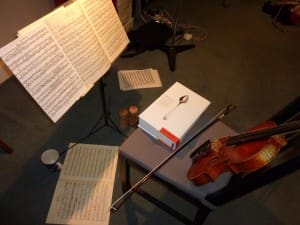by Rachel
“To give life to beauty, the painter uses a whole range of colours, musicians of sounds, the cook of tastes — and it is indeed remarkable that there are seven colours, seven musical notes and seven tastes.”
Lucien Tendret (1825-1896)
 Lately, I’ve been drawn to experimenting in the kitchen. What has led to this development I can’t be sure. Perhaps having the courage to improvise in the area of Life (leaving my job of 13 years and moving to Scotland) has led to the realisation that if I change something here or there in a recipe, or even make it up, nothing truly bad will come of it. The worst that can happen is that it tastes a bit funny, the texture might be not quite what I was hoping for …the best though, is that I create something that challenges and animates the taste buds, in fact, creates a whole sensory experience- in the preparation, the cooking, and of course, the eating (even the washing up).
Lately, I’ve been drawn to experimenting in the kitchen. What has led to this development I can’t be sure. Perhaps having the courage to improvise in the area of Life (leaving my job of 13 years and moving to Scotland) has led to the realisation that if I change something here or there in a recipe, or even make it up, nothing truly bad will come of it. The worst that can happen is that it tastes a bit funny, the texture might be not quite what I was hoping for …the best though, is that I create something that challenges and animates the taste buds, in fact, creates a whole sensory experience- in the preparation, the cooking, and of course, the eating (even the washing up).
Sharing food with loved ones is of course one of the basic pleasures of life. It amazes me how I can be excited about every meal, day in, day out, every single day of my life. Even if it’s only a piece of fresh warm bread, with delicious salty butter on it.
Creating food, like creating music, is a soul nourishing pastime.
I was thinking about all this the other day, while practising Ravel duo (it’s about to have its first outing next week in preparation for the festival, at a lovely house in Edinburgh). It’s a demon to figure out, but what an amazing, original piece..so many colours, layers, moods and textures! Practising it reminded me of cooking, trying to conjure up a tasty meal.

The practice room just now. Sitting on a cookbook (seat too low) and yes, those are salt and pepper grinders on the floor…i’ll explain another time..
Playing my instrument is a constant process of discovery, just like in cooking: knowing which colours and flavours work together, which ones need to be subtle, which ones need to hit you squarely and brazenly. And, conversely, the importance of knowing when to back off: having ‘palate cleansing’ moments, those that aren’t saturated with Colour and Meaning.
Food, like music, is temporal. The physicalities of the flavours and sounds are gone in a flash, but the impression lingers. Such complex layering of our minds, hearts and bodies creates extraordinary sensory experiences. Why else would we keep coming back for more?
How to create a rich musical experience (or a recipe)
Firstly, be realistic in deciding whether you have the tools and technique to pull this off (after all, you don’t want sweet scrambled eggs when the intention was to make a custard). Procedure counts for something.
Have a clear vision. Clearly define the flavours, colours and textures. What do you want your audience to feel and when? Is it to be a sculpted masterpiece or a comforting, informal affair? Or some of both?
Ingredients
Gather the purest you can find, those with the most flavour, colour and character. Know the qualities and textures of each ingredient, and how they react under pressure.
Method
Prepare. Take time to know your utensils and your audience. Listen to others who may have done this before, but listen to your own intuition first and foremost.
Decide on a basic structure but let it evolve as you progress. It may turn into something you didn’t altogether expect! You may find yourself adding a little this or that as you go along.
Commit to your vision wholeheartedly. Remember though, to find the right balance. Too rich can be just as unsavoury as too bland.
Remember that tastes and sounds have the ability to conjure up strong memories and emotions. Don’t take this with a grain of salt.
Some may dislike or even hate what you produce! Of course, rather that than no reaction at all.
Above all, add love. Food and music without love makes for a dry, stale biscuit of an offering.
 My 2 inspirational cooks for the day: Claudia Roden and Heidi Swanston.
My 2 inspirational cooks for the day: Claudia Roden and Heidi Swanston.

